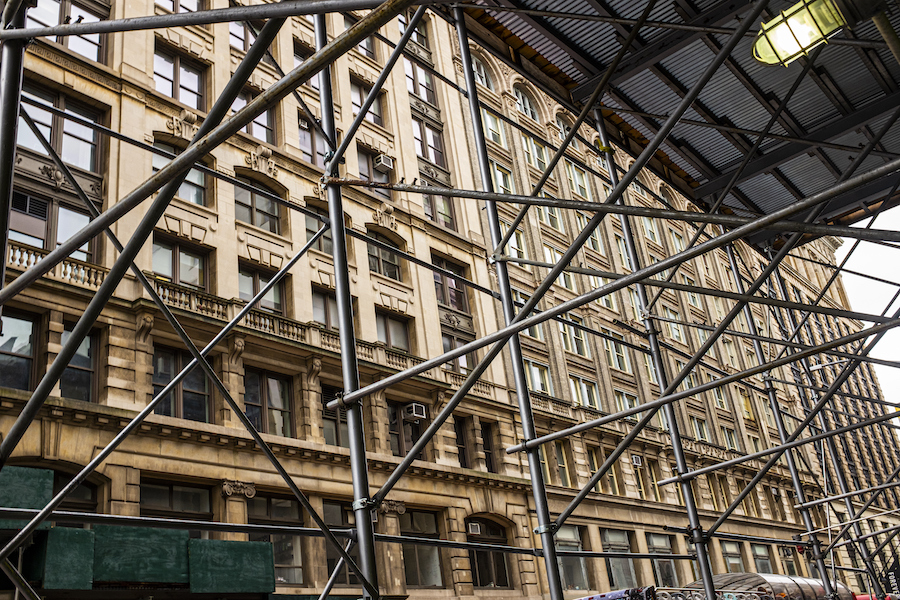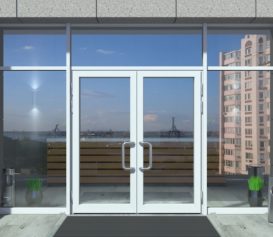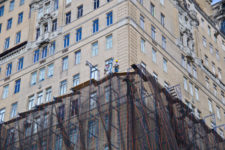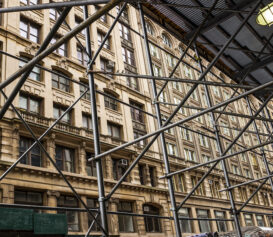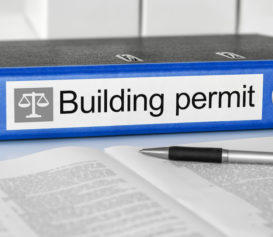We previously wrote about Manhattan Borough President Mark Levine’s proposals to Shed the Shed. Now, Mayor Adams has officially announced an initiative to “Get Sheds Down” as part of a major NYC sidewalk shed overhaul. Here’s what you need to know from the announcements, and what’s coming next.
Per the press release, this initiative seeks to perform “a sweeping overhaul of rules governing sidewalk construction sheds and scaffolding that will remove these eyesores from city streets more quickly while redesigning and reimagining those that are needed.”
Expanding Safety Netting Use
The Department of Buildings will post a future Bulletin (not available yet – will be posted “in 2023”) with details on rules for using safety containment netting, which can in specific cases be used in place of a traditional sidewalk shed. The Bulletin will also clarify how netting can comply with standard DOB specifications and provide adequate public protection. The DOB will engage with professionals to encourage broader adoption here.
DCAS (Department of Citywide Administrative Services) will “lead by example” and pilot the use of safety netting in place of a traditional shed for ongoing facade work in front of the Queens County Supreme Court on Sutphin Blvd. Here, the original shed was constructed more than 6 years ago and has been in place since. After the Bulletin is released, all city agencies will be required to assess the use of safety netting going forward “for any construction project on a building owned by that agency or where they serve as project sponsor or construction manager.”
Redesigning The Sidewalk Shed
The DOB is looking for proposals this summer to redesign the existing sidewalk shed structure. Design professionals (architects, engineers, etc.) are invited to submit new designs that are less obtrusive, more visually appealing, affordable, and safe for pedestrians. New designs selected during the RFP process will be incorporated into NYC’s construction codes, with a goal of implementing new designs by the end of 2024.
Per the release, “As the request for proposals process plays out to redesign the sidewalk shed, the Adams administration will partner with other city leaders to make immediate, interim changes to the existing plywood and pipe sidewalk shed design.” This includes more color choices beyond the current code-required shade of hunter green, permission to install artwork on shed panels, and allow for increased lighting under sheds.
Additional Enforcement And Oversight
Monthly Financial Penalties
New penalties would be issued to property owners for “most sidewalk sheds located in the public right of way that are not directly related to new construction or demolition projects.”
These penalties kick in 90 days after a shed is first permitted, and would be issued monthly until the shed is removed. Penalties would depend on the length of a shed at a given point in time (accounting for phased compliance), and may be reduced as work progresses and sheds get smaller in size.
The maximum monthly penalty would be $6,000, and waivers would be granted if owners take action to remove the shed within an allotted time. 1- & 2-family homes would be exempt from penalties, alongside buildings employing safety netting.
Central Business Districts
The Adams administration will target one business district in every borough besides Staten Island for increased enforcement. The hope is to spare smaller property owners from big penalties while reactivating sidewalk space in key central business districts.
Owners could be assessed a $10,000 penalty for failing to meet key milestones related to FISP:
- A shed is in place due to an unsafe façade, and;
- The property owner fails to meet any of the following deadlines during the repair process, including:
- Filing a repair application within three months
- Obtaining required work permits within six months
- Fully completing repairs within 24 months
These three milestones would supplement existing monthly penalties from the Department of Buildings for failure to make progress on required repairs under FISP.
Selected business districts are (as explicitly listed by the city):
- Midtown Manhattan
- Long Island City, Queens
- Downtown Brooklyn
- Grand Concourse, Bronx
New Fees For Permitting
New fees will be implemented for each renewal of sidewalk shed permits, with increase penalties when permits are expired and the shed remains in place. In a huge change, the DOB will also move to reduce the duration of shed permits from 12 months to 90 days. Owners would have to reapply more frequently throughout the year to keep sheds in place – especially since the DOB will no longer grant penalty waivers for expired shed permit violations.
Longstanding Sheds In Place Now
The DOB will expand its existing Long Standing Shed program, targeting owners with sheds that have been up for more than 5 years. Properties in the program receive additional scrutiny from the department, including more frequent site visits, possible criminal court actions, or even affirmative litigation in some cases. The DOB will lower the threshold from 5 years to 3 years, doubling the number of properties included in this enforcement program.
Low-Interest Loan Programs
The city, in conjunction with Borough President Levine, will explore new programs for low-interest loans to necessary facade work and repairs. It would be modeled after the mayor’s existing Small Business Opportunity Fund.
Facade Inspection And Safety Program
According to the press release, a plurality of sidewalk sheds in NYC are erected in connection with FISP-related work and inspections. To that end, the DOB will conduct a study to review the frequency of FISP inspections, and determine whether they can and/or should be less frequent, or whether less onerous inspections can be performed without jeopardizing pedestrian safety.
While it’s the smallest section of the press release, these words might have the biggest impact on owners and managers. With Cycle 9 ending soon, we might see a whole new FISP starting with Cycle 10 in 2025.
What Do I Do Now?
- Stay tuned for updates – Key parts of this overhaul is dependent on DOB releases, bulletins, and more. We’ll let you know when these come in, so stay tuned to the Blog & monthly compliance roundups
- Talk to your professionals – If you’re currently undergoing construction, plan on it, or wrapping up facade work from Cycle 9, talk to your expert vendors! They’ll know how to handle current sidewalk sheds, whether or not your properties are meeting key milestones, and what to do to make sure work is efficient and safe. If you haven’t, check out our post
- Continue to track your facade information – In addition to reviewing facade filing data from the DOB in your SiteCompli account, folks using Compliance Manager can actively track their progress at each property, and know what they need to focus on for each subcycle. If you want to learn more about facade filings in Compliance Manager, reach out to your Customer Success Manager.
